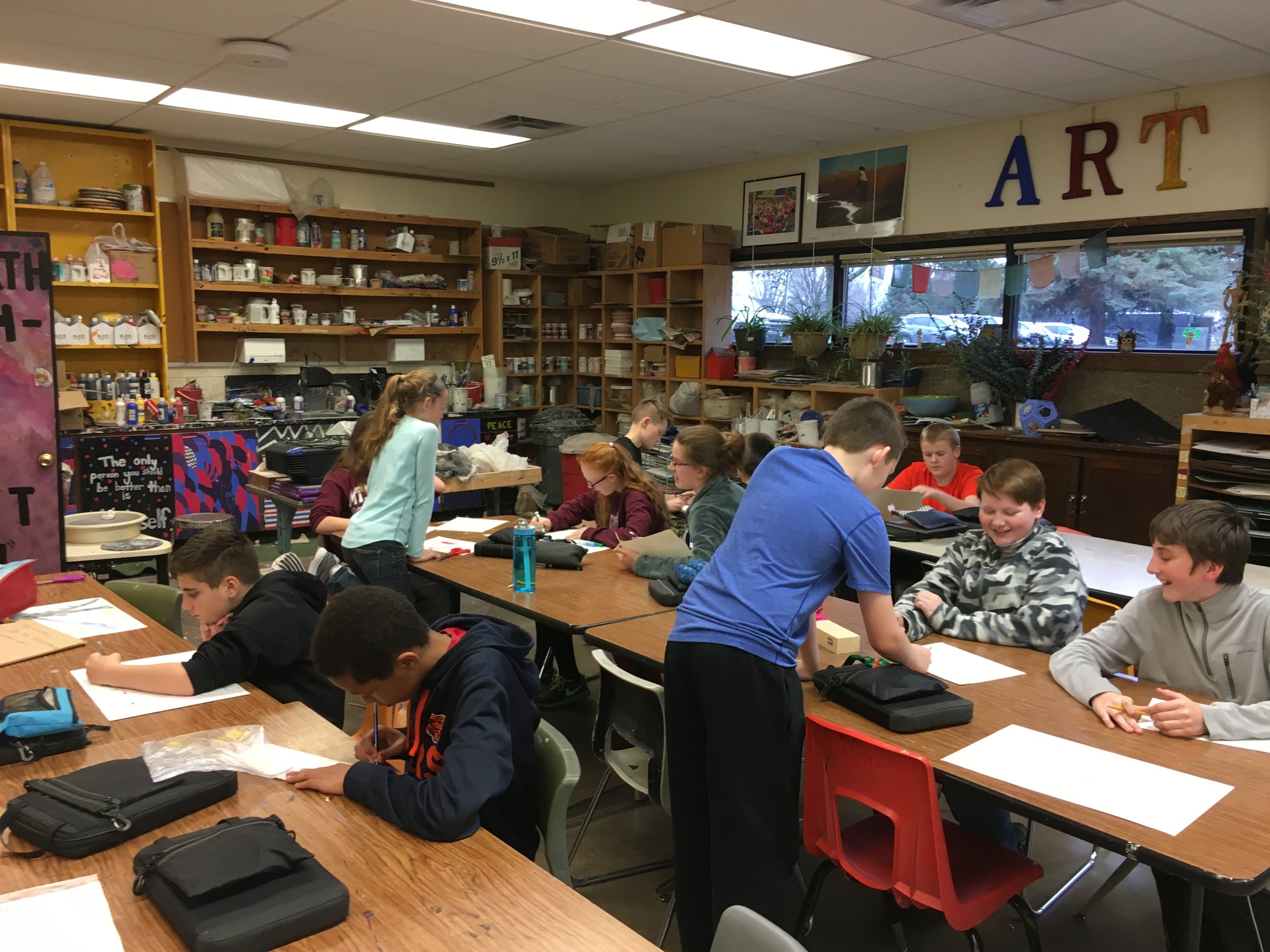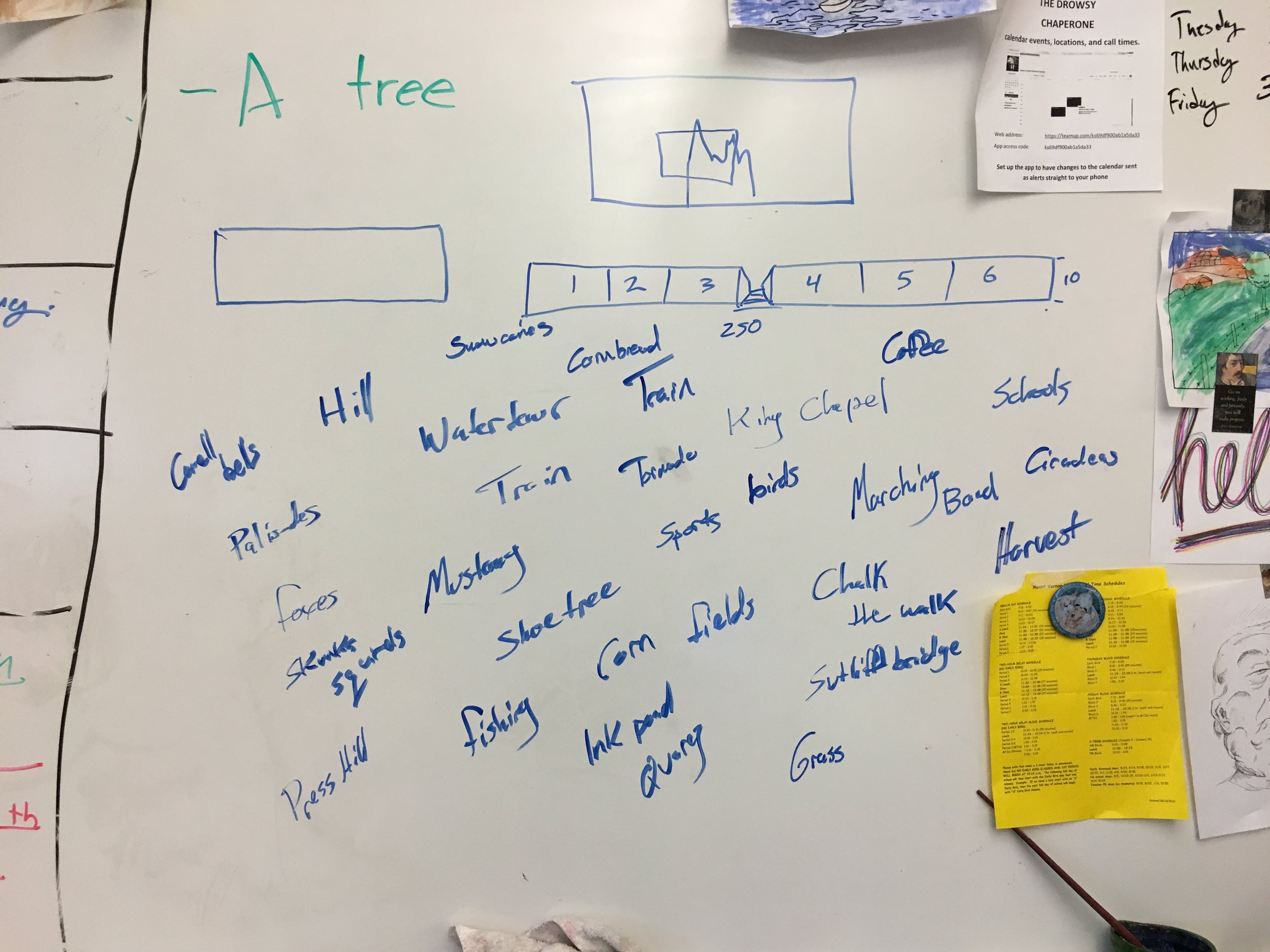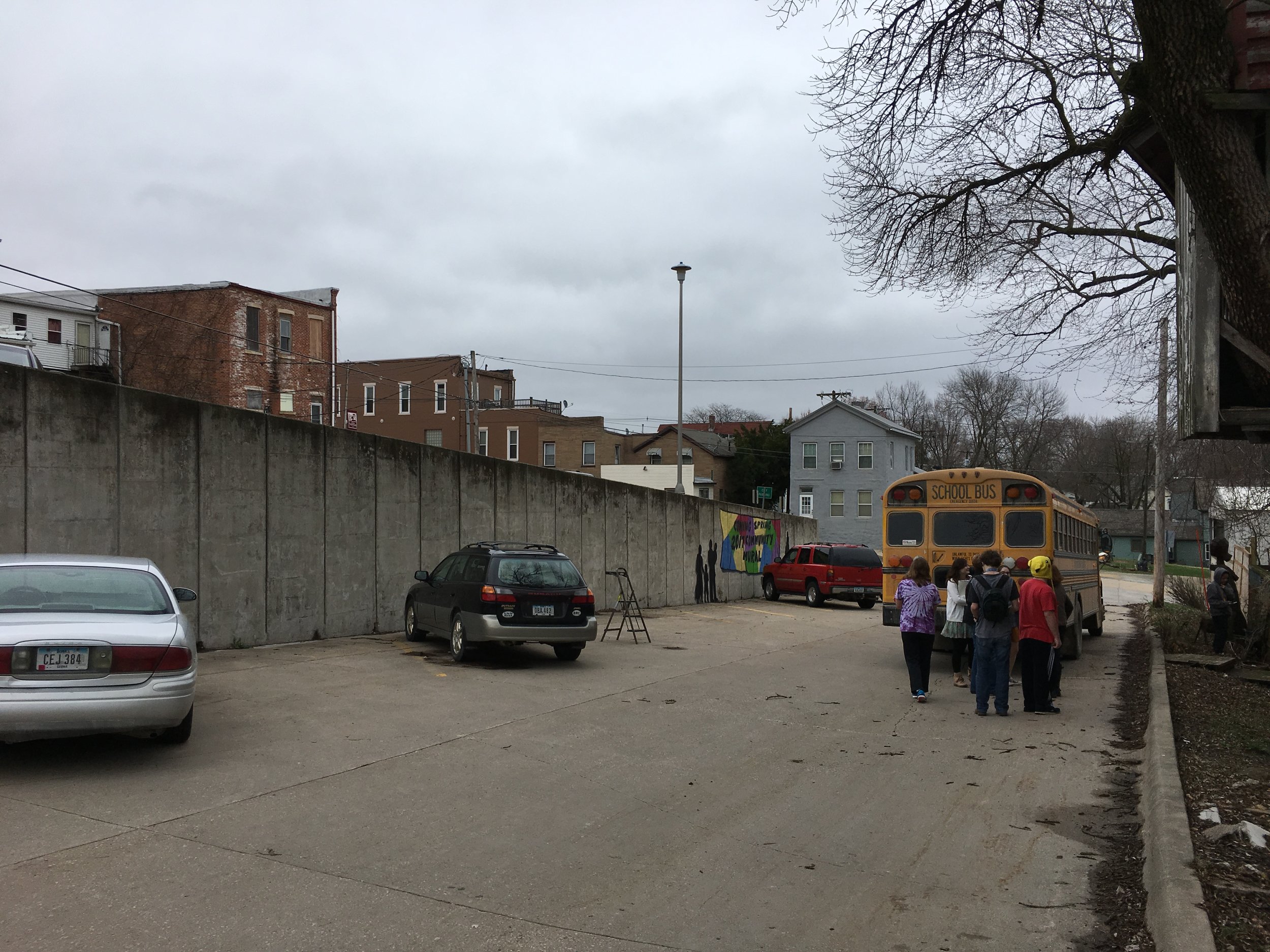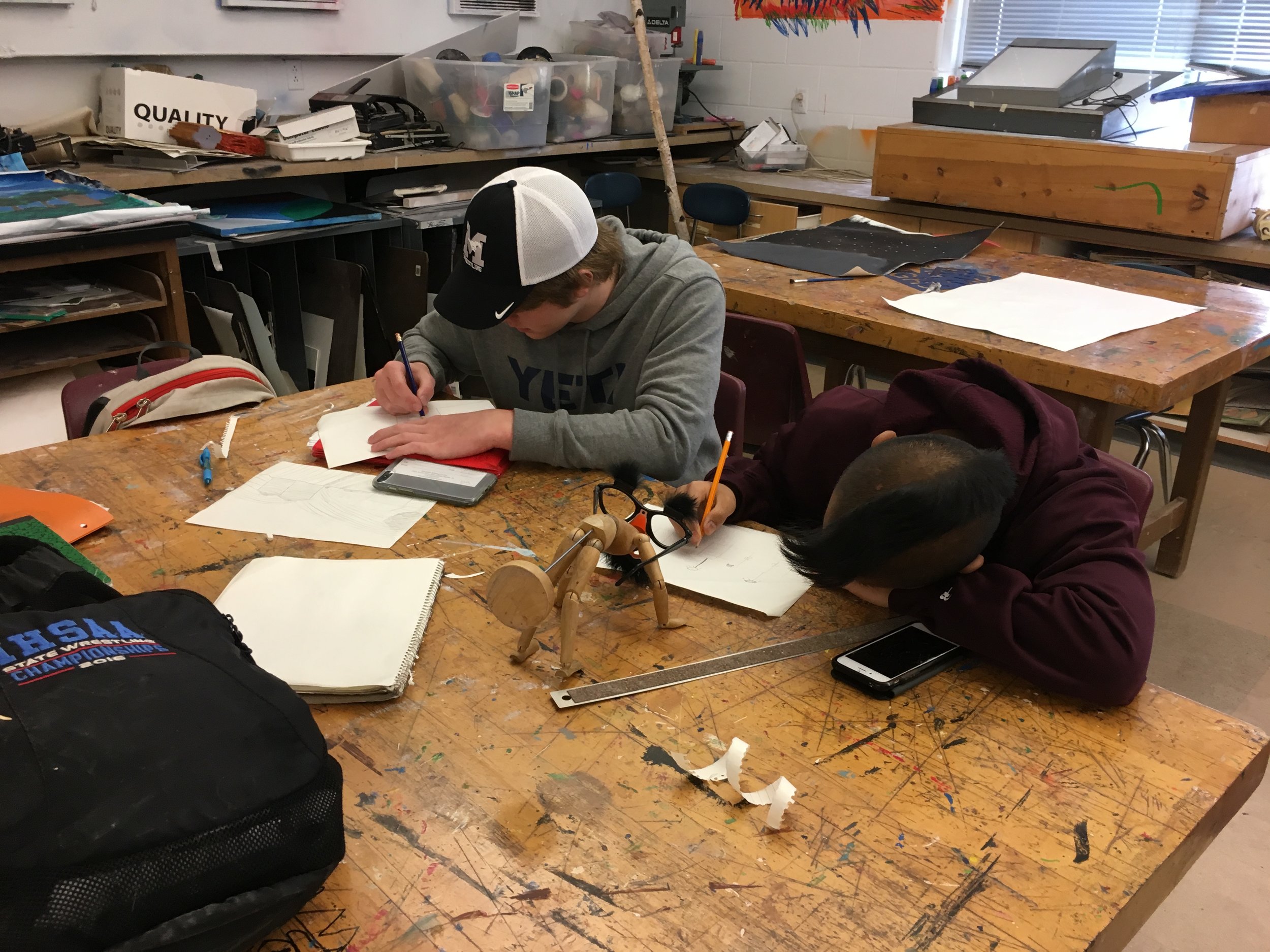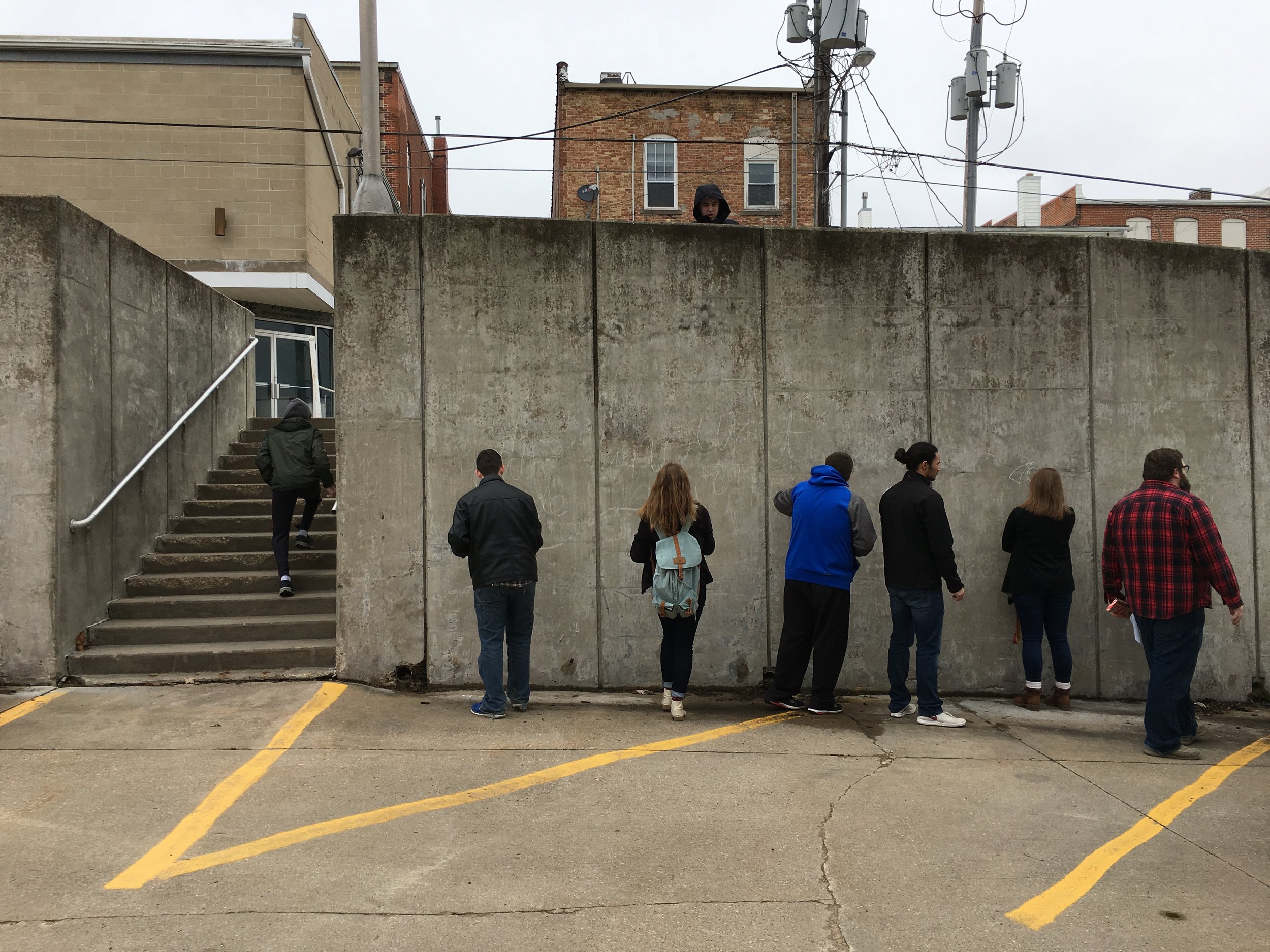A project 3 years in the making came to fruition in May 2017. In my hometown of Mt. Vernon, Iowa, I realized a massive youth-lead community mural on a retaining wall behind the house I grew up in. I used to draw on this big grey wall with chalk as a kid. In the fall of 2014 I was visiting for my cousin's wedding, and having completed some larger murals by that point, I began thinking of bringing a mural project to the town, centered around the local youth and giving them first-class arts education and a collaborative event that will be remembered the rest of their lives.
Strider Patton - Mount Vernon Iowa Youth Community Mural Project 2017 - Eastern wall
Elementary school assembly
With the help of my mom and several other dedicated believers in the project, I was able to pitch the project to the town's city council and school district. A unanimous "YES" was received immediately. The majority of the time over the three years was in securing a few grants and local financial donations. Once we knew we had the funding, I was began to schedule the mural design curriculum classes that I would bring to every school in town, serving K-12 grades.
Over the course of the last year, I flew to Mt. Vernon three times for mural design workshops, education opportunities in the schools, and a town hall meeting to open the conversation of what should be depicted in the mural to the larger community. Overall, I had hundreds of conversations which all boiled down to two main themes - nature and culture.
Working with the students, we decided to break the long wall down into six different scenes that would each tell their own story. I held a number of brainstorming exercises and design activities in the three grade schools to decide what each scene could depict. I gathered hundreds of sketches from these workshops, as well as pages of my own personal notes.
Outlining the mural for the first day of painting.
The designs span time, with imagery representing past, present, and even ideas and hopes for the town’s future. The scenes weave together the two main themes of nature and culture, along with more specific ideas, places, or concepts. The scenes may be observed individually or as an entire body of work.
The mural is divided into six cene that each have their own story and meaning. Each scene is filled with conceptual imagery, context, connotation and nuance. The scenes are intended to be immediately graspable, yet also loaded with layers of meaning. Observers may engage the imagery quickly, or take their time and allow the depth of each work to wash over them.
Moving from west to east, the entirety of the mural spans the length of a year, with four seasons represented among the six scenes. Starting with spring on the far west end of the mural, as observers move from left to right, they travel through summer, fall, and finally winter at the far east end of the mural.
Mount Vernon Community Mural KCRG TV-9 News Report
(click link above for TV news report video)
Weaving between the scenes is a linear line design that represents energy and connection, freely flowing from past to present, through seasons and times of day, and among nature and culture. This design represents the connectivity of everything, and how these places, people, and things make the community. This flow of energy culminates at the center point of the mural, where all the components come together and are realized to create the heart of Mt. Vernon, our home. It is at this unique point that observers can become participants, by walking up the stairs - physically moving into through the art.
The Scenes
Scene 1 "Rolling Heritage"
“Rolling Heritage”
This scene depicts the Mt. Vernon area landscape, with rolling hills, newly tilled farm fields, and windy skies in the springtime. A train is moving into the foreground, symbolizing a major part of Mt. Vernon’s history of transportation with moving people and goods. Seen in the natural skyand the human made train, energy is a major theme depicted here, along with the strong heritage the community has with the farming and the train.”
Scene 2 "Home - Indoors and Out"
“Home – Indoors and Out”
This scene represents the idea of home and how Mt. Vernon residents bridge that idea of being both indoors and out. Porches are common in the community, and these architectural elements represent this bridging of home being experienced outdoors. In the late springtime porches turn into places for residents to gather and rest outside after another winter. A setting sun with shining stars is in the background with two chairs on the porch and warm indoor lights coming on in foreground.
Scene 3 - "Celebration"
“Celebration”
This scene depicts Mt. Vernon’s long history of celebrating life with community festivals and events. From Fun Days, to Kolache Days and to Heritage days, a Ferris wheel is in the foreground, representing the history of annual celebrations as an iconic image. The big sky and white clouds are meant to show this scene on a hot mid-summer July afternoon. Celebrations have come and gone, moved and changed over time, but what remains through the ages is the tradition for residents to gather together in celebration of life.
The stairwell
The one unique feature of the retaining wall we painted was this stairwell. Something amazing about painting outdoors on wall that were not designed to be painted on, is that they already character, history, and charm. This stairwell connects the lower parking lot to the upper and offered an opportunity for observers to literally move through the artwork!
Scene 4 - "Residents - Old and New"
“Residents - Old and New”
In this scene a fox is in the foreground with fireflies drifting about in a farm field on an autumn night. Foxes are recent additions to the Mt. Vernon area, while fireflies have been around forever. These two creatures in the scene represent the idea of residents and how there are always those who have been in the area for a long time and those who are new. The town continues on with this natural ebb and flow of those who make up the community.
Scene 5 - "The Shoe Tree"
“The Shoe Tree”
Shown in this scene is The Shoe Tree, a local secret that is known by many residents. On the old dirt road west of town, the Shoe Tree has been a destination for residents who tie their old shoes together and hurl them into the branches of a tree, perhaps to leave their mark or perhaps to feel part of a tradition. This is a hidden treasure of the community and something unique that many residents may not know of. While this local secret is in the foreground, King Chapel stands tall in the background, an unmistakable iconic symbol of Mt. Vernon that even first time visitors know.
Scene 6 - "Pristine Winter"
“Pristine Winter”
This scene depicts a snowy landscape at the year's end. A freshly fallen coat of snow with no disruption represents the timeless cadence of the natural world of the Mt. Vernon area, free from any reference of humanity. This scene could be from the distant past, the present, or thefar future. The landscape is a major part of many Mt. Vernon residents’ identities, and trees play a large part of that. In the background are pine trees, and in the foreground, bare deciduous trees cast long shadows at the end of a cold day.
We could not have made this project happen would it not be for the incredible work and support by the people of Mt. Vernon, IA, the school board and teachers, the Mount Vernon Area Arts Council, and the City Council!
Specifically I would like to thank:
Grants:
- Iowa Arts Council
- The McIntyre Foundation
- Maurice Foundation
- ACT
Private Donations:
- East End Art
- Fuel...Art & Espresso
- Hands in Harmony
- Koppenhaver & Associates
- Mount Vernon Bank & Trust
- Stewart Baxter Funeral & Memorial Services
- Zoe's Pet Deli
Individuals:
- SteveMaravetz - President of the Mount Vernon Area Arts Council
- Marie DeVries - Mount Vernon Area Arts Council member and our grant writer
- Joe Jennison - Director of Mount Vernon / Lisbon Community Development Group
- Gary O'Malley - Mount Vernon Community School District Superintendent
- Sarah Fitzgerald - Washington Elementary School art teacher
- Mark Benesh - Mount Vernon Middle School art teacher
- Steve Andreson - Mount Vernon Middle School art teacher
- Christine Goodwin - Mount Vernon Area Arts Council member and my ever-supportive mom!


